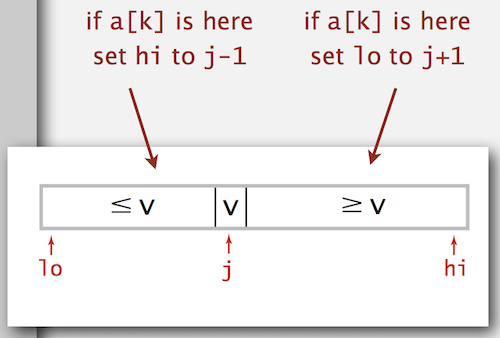Nothing special here. It’s just a blog post for summarising my algorithm learning course. Although this was already taught in the University, I didn’t even know that it can be used for Selection Problem
- Part 1 - Basic Implementation
- Part 2 - Selection Problems
- Part 3 - 3-way Partitioning
Selection Problem
Given an array of N items, find a kth smallest item. For example, an array A =
[5, 2, 9, 4, 10, 7], the 3rd smallest item is 5, the 2nd smallest item is 4 and the smallest
item is 2
The idea
- Based on Quick Sort
- Partition the array so that
- Entry
a[j]is in place. - No larger entry to the left of
j - No smaller entry to the right of
j
- Entry
- Repeat in one sub-array, depending on
j, finished whenjequalsk
Java Implementation
public static Comparable select(Comparable[] a, int k) {
StdRandom.shuffle(a);
int lo = 0, hi = a.length - 1;
while (hi > lo)
{
int j = partition(a, lo, hi);
if (j < k) lo = j + 1;
else if (j > k) hi = j - 1;
else return a[k];
}
return a[k];
}
The idea is that, after each partition, the item a[j] will be moved to the right place. So it will
become the jth smallest item. Repeat that process until we can find j = k.

Performance
Quick-select takes linear time on average. Quick-select uses ~½ N2 compares in the worst case, but (as with quicksort) the random shuffle provides a probabilistic guarantee.
